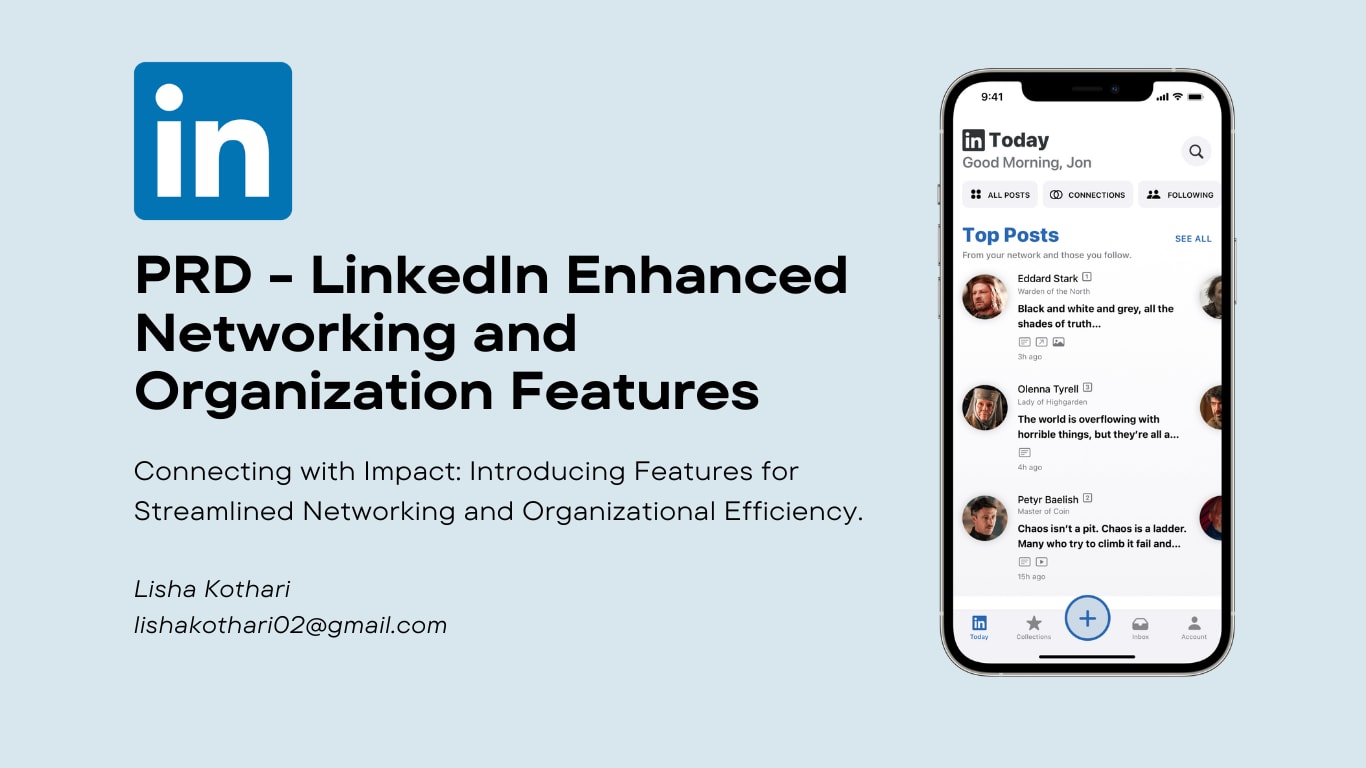PRD - LinkedIn Enhanced Networking and Organization Features
Objective: The objective of this PRD is to outline key feature enhancements for LinkedIn's platform, focusing on improving connection management, expertise grouping, and item organization. By addressing these areas, I aimed to provide LinkedIn users with a more streamlined and personalized experience, allowing them to effectively manage their connections, showcase their expertise, and organize their saved items.
Approach: As an avid user of LinkedIn myself, I understand the importance of connecting with others and staying organized. To develop this PRD, I conducted in-depth user research and collected valuable feedback from my colleagues & friends. By diving into the user experience, I identified pain points and sought inspiration from successful platforms to inform the design and development of these feature enhancements.
Key Sections:
Introduction:
- Overview: This section provides an introduction to the PRD, emphasizing the need for feature enhancements on LinkedIn to cater to user demands and expectations.
- Objectives: Clearly defined objectives showcase our commitment to enhancing connection management, expertise grouping, and item organization.
User Stories:
- User Story 1: Group LinkedIn Connections and Lists: As a LinkedIn user, I want to group my connections into personalized lists to easily track updates and posts that matter to me.
- User Story 2: Grouping Contacts by Expertise and Job Title: As a LinkedIn user, I want to categorize my contacts based on their expertise and job titles, enabling targeted connection requests and collaboration.
- User Story 3: Organizing Saved Items and Bookmark Threads: As a LinkedIn user, I want to organize my saved items and bookmarked threads into relevant tabs for easy access and retrieval.
Functional Requirements:
- Feature 1: Connection Grouping and Lists: This feature allows users to create personalized connection groups and lists, making it easier to manage and engage with relevant updates and posts.
- Feature 2: Expertise Grouping and Job Title Categorization: Users can categorize their contacts based on areas of expertise and job titles, facilitating targeted connection requests and productive collaborations.
- Feature 3: Item Organization and Bookmarking: This feature empowers users to organize their saved items and bookmarked threads into themed tabs, enhancing efficiency and facilitating knowledge management.
User Interface Design:
- Mockups: Visual representations illustrate the proposed UI changes for each feature, showcasing an intuitive and visually appealing design.
Technical Requirements:
- Infrastructure and Technology: This section outlines the necessary technical considerations, including scalable infrastructure, data storage, and seamless integration with existing LinkedIn architecture.
Implementation Plan:
- Development Milestones: Detailed breakdown of tasks into smaller milestones to ensure efficient development and implementation of each feature.
- Testing Approach: Strategies for comprehensive testing to ensure the functionality, usability, and seamless integration of the new features.
- Deployment Strategy: Plan for the phased deployment of the feature enhancements, minimizing disruption and ensuring a smooth user experience.
Risks and Mitigation:
- Identified Risks: Potential risks associated with feature development and implementation, such as technical complexities or user adoption challenges.
- Mitigation Strategies: Proactive strategies to address and mitigate the identified risks, ensuring successful execution of the feature enhancements.
Success Metrics:
- Success Metrics & KPIs: Defined metrics to measure the success and effectiveness of the implemented features, including user engagement, satisfaction, and increased productivity
Learnings: Throughout the process of conducting user research, gathering feedback, and analyzing industry trends, several valuable insights have been gained, shaping the direction of the feature enhancements. Key learnings include:
- Users highly value the ability to personalize their LinkedIn experience and efficiently manage their connections.
- Organizing contacts based on expertise and job titles enhances networking and collaboration opportunities.
- Users desire better organization and accessibility of saved items and bookmarked threads for improved productivity.
- Seamless integration and intuitive user interfaces contribute to a positive user experience and increased engagement.
Conclusion: In conclusion, the proposed feature enhancements outlined in this PRD have the potential to revolutionize the LinkedIn experience. By addressing connection management, expertise grouping, and item organization, LinkedIn aims to provide users with a more personalized, efficient, and engaging platform.
These enhancements will empower users to foster stronger connections, leverage their expertise, and stay organized within the LinkedIn ecosystem.
18 Jun 2023







